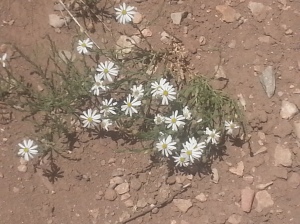White Heath Asters are blooming on my property and are pretty plants for flowerbeds. It is a prairie aster that grows in central North America but not on either coastline.
This little flower is charming, and a perennial well suited to living with others in flowerbeds. As a nutrient accumulator, White Heath Aster brings minerals from subsoils to surface for other plants that cannot do so and it is part of a process that takes inorganic minerals and puts them in bioavailable form. Every healthy ecosystem and circular economy needs nutrient accumulators among the mix to keep soils productive. White Heath Aster is an exceptionally pretty nutrient accumulator, a definite plus in my food forest and potager.
If there are high levels of selenium in the soil and the soil is degraded by overgrazing, nutrient accumulators like White Heath Aster can be present in excessive numbers. As a normal part of the mix, it is fine, in excessive numbers it can be toxic to livestock. Even then, only in areas with high selenium levels in the soil.
White Heath Aster is sometimes eradicated with Roundup as if it were the problem; however, other nutrient accumulators also uptake selenium when it is present at high levels. There is an alternate approach not often taken… stop overgrazing.
States that have higher selenium levels in their soil usually originate on Cretaceous shales and include South Dakota, Montana, Wyoming, Nebraska, Kansas, Utah, Colorado, and New Mexico. High selenium can be a problem where rains are less than 20 inches and damaging grazing practices require “fixer” plants in high numbers. During long western droughts the problem intensifies and many areas cannot be intensively grazed because overgrazing promotes nutrient accumulators and they can pick up too much selenium for livestock health. A balanced mix happens naturally when the land is not overgrazed.
Selenium is good. It is an essential trace mineral and required for health. It is used for making antioxidant enzymes and preventing cell damage. It prevents cancers and cardiovascular disease, even from heavy metals. Market economy supplemental selenium is usually in the inorganic form and can be toxic to humans. The proper form is bioavailable in food. A reasonable mix of nutrient accumulators like White Heath Aster maintains that balance. Mass eradication of nutrient accumulators on damaged soil is exacerbating the problem of overgrazing. Eventually the soil will be damaged so badly it will be abandoned like millions of acres already have been in the United States.
At this time corporate farm soils are depleted of minerals and other nutrients, our food is also depleted. Even as we use those food scraps in our home compost they are lower in nutrients. It is estimated that our food is about 1/10 as nutritious as it was in 1950. Our bodies are hungry.
New soil like mine is still mineral dense, but is in the process of making those minerals bioavailable through soil fungi and bacteria that bring those nutrients to plants. They work with nutrient accumulators like White Heath Aster to shift minerals from subsoil to topsoil. Every winter when these pretty asters die back, some of those newly bioavailable minerals become available to others plants as they enrich the topsoil.
Little selenium accumulators like White Heath Aster are doing their job, which is the designated job of most plants that colonize damaged and disturbed areas. Over grazing these areas causes problems with livestock eating plants that are healthy for the ecosystem but not healthy in excessive amounts for livestock. The local ecosystem collapses eventually.
A problem we are facing as human beings as well. As we deplete our soils and use Roundup on nutrient accumulators, we lose large areas that once produced healthy food. As we keep pushing, those areas collapse.
For those of us who are taking food production into their own hands on a smaller scale, we can easily allow nature to regenerate our soils and add any deficiencies. The corporate food system is unsustainable and will crash from greed, because scientists are well aware of these problems as are their bosses. No amount of GMO seeds and pesticides will solve the problem; if it could, millions of acres of US farmland would not already be destroyed and out of production with millions more on the edge.
Allowing the natural system that has worked for a billion years to continue to work is the easiest and fastest way to solve these problems. It will not enrich Monsanto, Syngenta, Dupont, Dow, Bayer, and the politicians they buy. It will not enrich Big Pharma through the supplements money machine they own and the drugs they sell when your body breaks down. It will enrich you.
I am keeping my White Heath Asters wherever they grow. I will not eat them but I will eat the products of their labor secondhand and enjoy their beauty as they go about enriching my topsoil. White Heath Aster seeds are wind dispersed so if I want them in a particular place, I’ll have to pay attention and grab them before they are gone.

